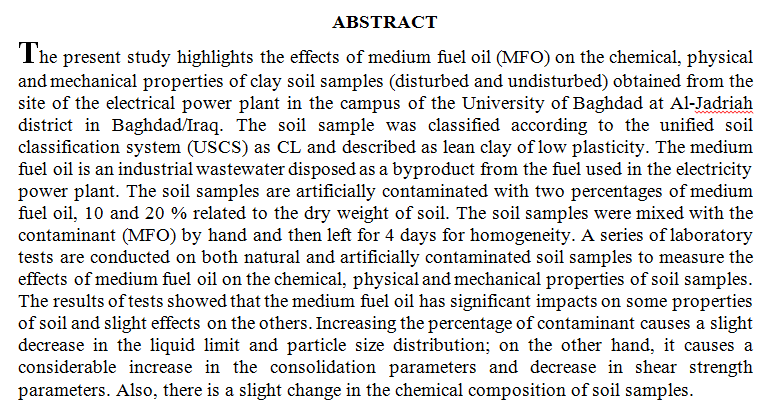
Background: Poly (methyl methacrylate) has several disadvantages (poor mechanical properties) like impact and transverse strength. In order to overcome these disadvantages, several methods were used to strengthen the acrylic resin by using different fibers or fillers. This study was conducted to evaluate the effect of Plasma treatment of the fiber on mechanical properties Poly (methyl methacrylate) denture base material. Materials and methods: Specimens were prepared from poly methyl metha acrylic (PMMA) divided according to present of fiber into 4 groups (first group without fiber as control group, second group with Plasma treated polyester fibers, third group with Plasma treated polyamide fibers and fourth group Plasma treated combination
... Show More (2)
(2)
An investigation was conducted effect of addition co- solvent on solvent extraction process for two types of a lubricating oil fraction (spindle) and (SAE-30) obtained from vacuum distillation unit of lube oil plant of Daura Refinery. In this study two types of co-solvents ( formamide and N-methyl, 2, pyrrolidone) were blended with furfural to extract aromatic hydrocarbons which are the undesirable materials in raw lubricating oil, in order to improve the viscosity index, viscosity and yield of produced lubricating oil. The studied operating condition are extraction temperature range from 70 to 110 °C for formamide and 80 to 120 °C for N-methyl, 2, pyrrolidone, solvent to oil ratio range from 1:1 to 2:1 (wt./wt.) for furfural with form
... Show MoreIn this study NiO - CoO bimetallic catalysts are prepared with two Ni/Co ratios (70:30 and 80: 20) using the precipitation method of nitrate salts. The effects of Ni /Co ratio and preparation methods on the catalyst are analyzed by using different characterization techniques, i.e. atomic absorption (AA) , XRD, surface area and pore volume measurements according to the BET method . The results indicate that the best catalyst is the one containing the percentage of Ni :Co ( 70 : 30 ). Experiments indicate that the optimal conditions to prepare catalyst are stirring for three hours at a temperature of 60oC of the preparation , pH= (8-9) , calcination temperature at 400oC for two hours
... Show MoreThis research studies the rheological properties ( plastic viscosity, yield point and apparent viscosity) of Non-Newtonian fluids under the effect of temperature using different chemical additives, such as (xanthan gum (xc-polymer), carboxyl methyl cellulose ( High and low viscosity ) ,polyacrylamide, polyvinyl alcohol, starch, Quebracho and Chrome Lignosulfonate). The samples were prepared by mixing 22.5g of bentonite with 350 ml of water and adding the additives in four different concentrations (3, 6, 9, 13) g by using Hamilton Beach mixer. The rheological properties of prepared samples were measured by using Fan viscometer model 8-speeds. All the samples were subjected to Bingham plastic model. The temperature range studi
... Show MoreThis research deals with the study of top soil electrical conductive regions located within Baghdad City. The research included measuring the dissolved soil material extraction Electrical Conductivity (EC) with an aqueous solution for the top (0-30 cm) soil layer of the study area. As the electrical conductivity values increase by increasing the amount of dissolved salts in principle, we can consider that the aim of this research is to predict the amount and distribution of (soil contamination with salts) which is represented by the (Salt Index), this factor calculated for each soil representative sample taken from the region with a depth of (30 cm). Laboratory (EC) test values measured by the use of solutions (EC) digital meter for the ex
... Show MoreFour new copolymers were synthesized from reaction of bis acid monomer 3-((4-carboxyphenyl) diazenyl)-5-chloro-2-hydroxybenzoic acid with five diacidhydrazide in presence of poly phosphoric acid. The resulted monomers and copolymers have been characterized by FT-IR, 1H-NMR, 13C-NMR spectroscopy as well as EIMs technique. The number averages of molecular weights of the copolymers are between 4822 and 9144, and their polydispersity indexes are between 1.02 and 2.15. All the copolymers show good thermal stability with the temperatures higher than 305.86 C when losing 10% weight under nitrogen. The cyclic voltammetry (CV) measurement and the electrochemical band gaps (Eg) of these copolymers are found below 2.00 ev.
This study is concerned with the effect of adding two kinds of ceramic materials on the mechanical properties of (Al-7%Si- 0.3%Mg) alloy, which are zirconia with particle size (20μm > P.S ≥ 0.1μm) and alumina with particle size (20μm > P.S ≥ 0.1μm) and adding them to the alloy with weight ratios (0.2, 0.4, 0.6, 0.8 and 1%). Stirring casting method has been used to make composite material by using vortex technique which is used to pull the particles to inside the melted metals and distributed them homogenously.
After that solution treatment was done to the samples at (520ºC) and artificial ageing at (170ºC) in different times, it has been noticed that the values of hardness is increased with the aging time of the o
... Show MoreAdsorption studies were carried out to test the ability of the Iraqi rice bran (Amber type) to adsorb some metals divalent cations (Cd2+, Co2+, Cu2+, Fe2+, Ni2+, Pb2+, and Zn2+) as an alternative tool to remove these pollutants from water. The Concentrations of these ions in water were measured using flame and flamless atomic absorption spectrophotometry techniques. The applicability of the adsorption isotherm on Langmuir or Freundlisch equation were tested and found to be dependent on the type of ions. The results showed different adsorptive behavior and different capacities of the adsorption of the ions on the surface of the bran. The correlation between the amounts adsorbed and different cation parameters including (electronegativity, io
... Show More